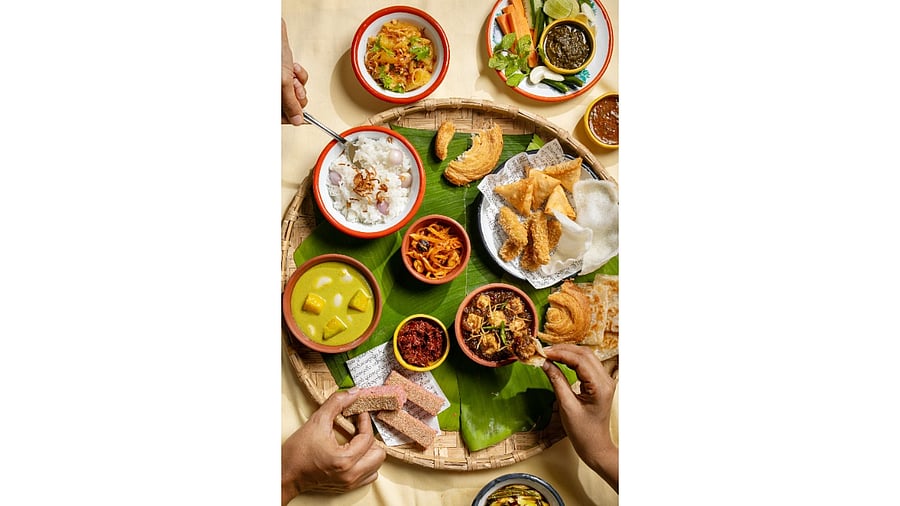
A sumptuous platter marks Thingyan Festival.
Credit: Burma Burma
Come summer and several communities in India celebrate the New Year in their own unique way. While India celebrates Puthandu, Vishu, Baisakhi, or Bohag Bihu, some Asian nations like Cambodia, Thailand, and Sri Lanka also share similar cultures and traditions. In addition to symbolising joy, prosperity, new beginnings, and the changing seasons, these festivals also bring forth a multitude of delectable culinary offerings.
A sumptuous Burmese platter
Burma observes the annual Thingyan Festival in April, and celebrations often go on for longer. A sumptuous platter catches everyone’s fancy, offering fresh citrus fruits for salads, seasonal greens like sorrel (gongura), fermented tea leaves for dips, and a variety of tubers and beans. “Traditional delicacies like coconut rice (jasmine rice cooked overnight in coconut milk), pumpkin and broad beans curry, sweet lemon-shallot salad, mushroom roselle stir fry and banana sawin makin (a steamed fusion of bananas, strawberries and semolina dusted with poppy seeds on the top) are served only during the Thingyan festival and I have memories of my mother making them at home,” explains Ankit Sharma, founder of Burma Burma. Small eats like samosa fritters and sweet potato fries served as street food during this time also make it to the platter.
“The Thingyan festival goes on for four days in Burma and consists of different rituals, dances and of course, food. There is a complete carnival-like atmosphere in the nation and the festival ends with people playing with water,” he adds.
A Nepalese thali anyone?
For the Nepalese, the New Year is associated with rath yatras, temple visits and cleaning of homes. As part of the feasting, yomari (steamed rice flour dumplings filled with chaku or jaggery toffee, sesame seeds, khoya (evaporated milk solids), and shredded coconut) and sel roti (a traditional homemade sweet ring-shaped rice bread/doughnut) are served with aloo dum or meat curry. “Families get together to make yomari, and young people go around the neighbourhood singing, asking for yomari.
People make various shapes of yomari, including shapes of gods and goddesses such as Lakshmi, Ganesha, Kubera, and Saraswati, and place it in the bhakari — a large grain basket used for storing — as an offering to the gods, thanking them for a good harvest. In the town of Sankhu, locals also take out a procession for Lord Ganesha; and in Harisiddhi, locals perform a masked dance,” says Dechen Dolkar, owner of Utse, a restaurant that specialises in Himalayan cuisine. Utse celebrated the Nepalese New Year with a special thali prepared by the local ladies which consisted of sel roti, yamari, tomato chutney and chicken or meat curry.
“Our meat for the New Year is dry with gravy being served separately to dip the bread in. Desserts comprised of Indian sweets like gulab jamun, rasgulla or kheer. Rasgulla is interestingly served with curd for a unique taste,” adds Dechen.
Tastes of Thailand & Cambodia
“The Khmer culture has its roots in Hinduism and hence, there are many similarities between their cuisine and ours. There’s also a lot of usage of turmeric, coriander and cumin. Other than the use of coconut milk, the Khmer chicken curry is very close to our desi Bengali home-style chicken curry,” states Priyanka Bonick, managing partner, Kampot, a restaurant which specialises in Vietnamese, Cambodian and Korean cuisine.
Inspired by the roots of Khmer cuisine, the restaurant celebrated the Cambodian New Year with a Khmer menu consisting of tangy pink fire salad, samlor korkor (Khmer version of a hotpot), stir-fried vegetables with Kampot pepper, Khmer satay in veg and non-veg, Khmer spring rolls, chha trob (grilled eggplant served in lettuce wraps), Khmer curry with pav or rice and banana brulee. Cambodia’s neighbouring country Thailand too observes Songkran/Thai New Year during this time of the year. In celebration of Songkran, Thai Alley in Bengaluru offered delectable delights such as pla rad prik (deep-fried tilapia fish with chilli sauce), pad ka prao (tofu) and the much-loved pad Thai.
“Filled with acts of merit, vibrant parades, dazzling pageants, and the renowned water extravaganza, Songkran encapsulates the essence of Thai culture, blending tradition with an unmistakable spirit of enjoyment. Central to this celebration is the rich tapestry of Thai cuisine, celebrated worldwide for its exquisite flavours and culinary artistry,” says Dr Vilailak Rungmaungthong, founder of the restaurant. He was raised in Petchabun, Thailand.
Essence of Sri Lanka
The Sri Lankan New Year is traditionally celebrated by the Tamil and Sinhalese people. “We are a rice-eating island and rice is always associated with good news and auspiciousness. During this time, the newly-harvested rice is cooked in a pot and finished with coconut milk, cut into squares and eaten with sambol or a coconut jaggery mixture,” informs Priya Bala, who runs Yo Colombo, a sustainable Sri Lankan cloud restaurant. “This mild and creamy dish, called kiribhath, marks the beginning of every auspicious occasion for us Sri Lankans. Some of the other dishes prepared during this time are achi murukku or rose cookies and oil cakes or adhirasam,” adds Priya.
Priya fondly recalls the communal tradition of sharing kiribhath among households, underscoring the ritual’s nostalgic and comforting essence.
For Priya, one of the fondest memories of the New Year from back home would be how each household shared kiribhath with the other. “Though every family would make the same thing, it would still be shared among the entire community. It’s a beautiful and comforting ritual, surrounded by a lot of nostalgia,” she sums up.